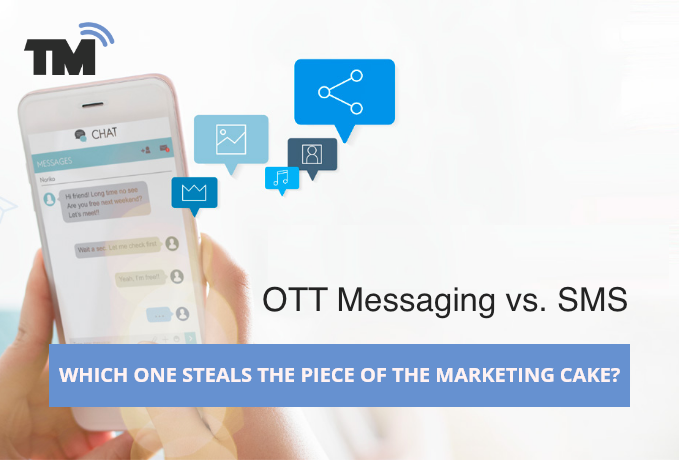If your customers have interacted with your brand over an instant messaging platform other than SMS and emails, congratulations! You’ve gone omnichannel in the true sense. And many of these OTT apps aim high to hold their footing firm in the marketing industry.
No wonder many of these have been trying to oust SMS for some time now. But SMS has only WhatsApp as its close competitor, according to Mobile Ecosystem Forum’s 2021 report.

What is OTT Messaging?
When text-based communication, viz SMS or Short Message Service, was introduced in the 1990s, it gripped the world for nearly 2 decades. With smartphones gaining prominence early in the last decade, many apps came into existence that use the internet to facilitate communication between 2 parties. This gave rise to OTT platforms for messaging, entertainment, calling, and gaming.
OTT or Over-the-Top technology works over an existing system. For instance, WhatsApp works over the internet with the help of a user’s mobile number for quick text communication. Skype works over voice calling feature using the internet. Likewise, OTT messaging works over the internet and has given birth to instant messaging services. WhatsApp, Viber, Facebook Messenger, and WeChat are some examples.
Let’s understand the differences between SMS and OTT messaging marketing methods through their benefits.
Benefits: OTT Messaging Vs. SMS
- Delivery
Bulk SMS having a 98% open rate is the most successful marketing channel to penetrate a brand’s audience. It gets delivered fast over a subscriber’s network. OTT messaging sustains over the facility of the internet.
OTT messaging works as long as your users are connected to the digital world. They may or may not need a phone number like WhatsApp and LinkedIn messenger, respectively. While SMS might charge your users a tiny fee, OTT messaging channels don’t incur any additional cost other than the ubiquitous internet and hence come inexpensive for the users.
- Reach
9 out of 10 SMSes are read within 3 minutes of delivery. Hence, have a good reach with reliability for bulk outreach. On the contrary, OTT messaging still doesn’t allow brands to send bulk updates or messages to their users. This makes SMS a preferred choice for bulk marketing.
However, with personalization and appealing aesthetics, OTT messaging channels gain an edge in engaging your users. And hence, a better user experience, as mentioned next.
- User Experience
OTT messaging demands an app to be downloaded, and not to forget, every mobile OS needs a different version. On the other hand, SMS comes as the default messaging tool on all phones and is OS agnostic.
With numerous features like emoticons, group chats, calls, and a large file-sharing facility for images, audios, and videos, an OTT messaging system wins over SMS. Especially in the case of personal use.
SMS usage among iOS and Android users is similar in percentage. In the case of WhatsApp, the latter group leans toward this popular app compared to the iOS users.

- Security and 2FA
SMS and, more importantly, A2P (application to person) communications are regulated by various governments and regulatory authorities to avoid spamming and fraud. Due to SMS’s limited features, the chances of a user’s phone getting hacked or spammed through irrelevant videos and multimedia files are less in this docile texting tool.
A2P messages often include OTPs, bank updates, appointment reminders, mobile ticketing, etc. With the rise in 2-factor authentication (2FA), security has increased, and SMS plays an important role in delivering one-time passcodes to users. OTT messaging channels are still far from offering this facility to their users.
So, even after having simple features, SMS becomes an indispensable part of a brand’s marketing endeavors.
Why Plain SMS is Still Preferred
Despite having deployed aesthetically appealing OTT messaging, SMS can be a brand’s priority for so many reasons:
- Reliability plays an important role, and stats have confirmed that SMS is the most reliable marketing channel.
- Being mobile agnostic makes SMS a viable tool for mass marketing and customer outreach.
- Easy to use for all age groups among users and is accessible almost everywhere.
- 2FA makes use of an SMS system for all user-based authorizations.
- Cloud API providers like Textmunication reduce your overall cost to a minuscule value, unlike a third-party provider.
What is Your Gameplan?
Whether you use OTT messaging or SMS, the Textmunication team advises you to use the right mix of each platform for omnichannel marketing to engage your users. Keeping in mind the best of both the marketing channels, you should make a goal-oriented strategy. If you need assistance in bulk SMS marketing, our experts are all geared up to help you. Reach out to us here.
